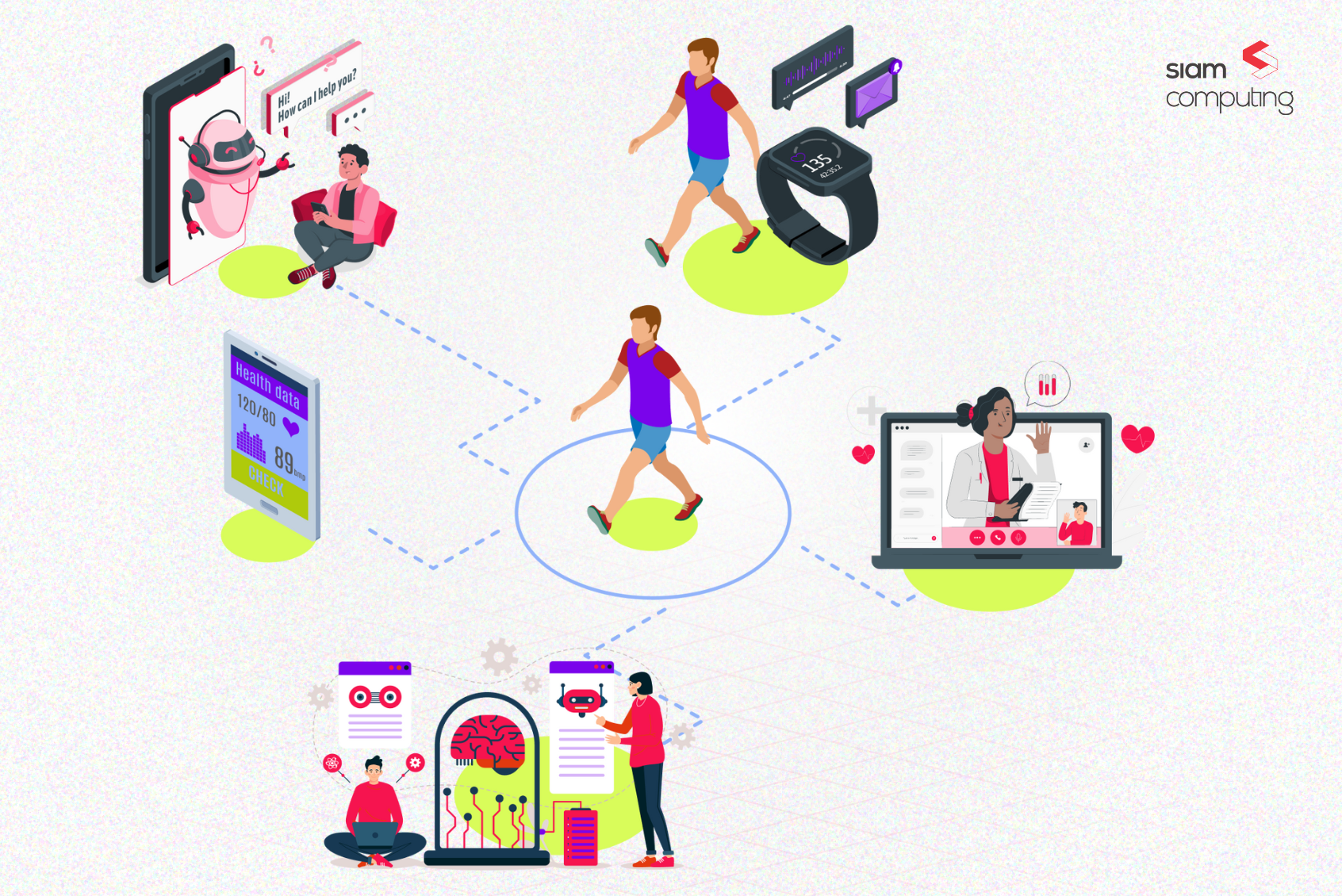You’re probably enamored by the buzz around artificial intelligence (AI) in recent years, and you might be wondering how you can add a bit of AI magic to your product. But the journey into the realm of AI is not just about catching the buzz; it’s about unlocking the unparalleled potential that AI holds for enhancing your product’s scope and user experience.
AI, encompassing machine learning, deep learning, natural language processing, GenAI, computer vision, and more, holds the power to enhance your product’s capabilities, making it smarter, more intuitive, and ultimately more valuable to users. In this article, we’ll delve into the core of AI to understand its fundamental principles and identify key integration opportunities within your digital landscape.
Whether you’re a seasoned product leader or just starting your journey, we hope this guide helps you ask and answer the critical first questions before you infuse AI into the products you are building.
Understanding AI in Product Development
Let’s start with the basics. At its core, AI is about machines learning from data and making smart decisions. Imagine having a digital assistant that learns from user interactions, predicts user preferences, and provides a personalized experience by making recommendations tailored to individual needs. That’s the power of AI in action. It’s about enhancing your product’s capabilities, making it smarter, more intuitive, and ultimately more valuable to your users.
Identifying Opportunities for AI Integration
Now that we have a grasp on what AI is, let’s explore where it can work its magic within your product. There’s a myriad of opportunities, but let’s focus on a few key scenarios:
1. Automation of Repetitive Tasks
AI can be your digital workforce, taking care of mundane, repetitive tasks, freeing up your human talent for more creative and strategic endeavors. Think about automating data entry, content moderation, or customer support — the possibilities are endless.
2. Personalization and Recommendation Systems
Users love products that understand and cater to their unique preferences. AI-driven recommendation systems analyze user behavior to suggest products, content, or features that align with individual tastes. This not only enhances user satisfaction but also boosts engagement and retention.
3. Predictive Analytics for Decision-Making
Ever wished you had a crystal ball for making decisions? AI, with its predictive analytics capabilities, comes pretty close. From demand forecasting to identifying market trends, incorporating AI into your product can give you a competitive edge by making informed decisions based on data-driven insights.
4. Conversational Interfaces through Natural Language Processing (NLP)
With NLP, your product can understand and respond to human language, opening up new possibilities for intuitive interfaces. Chatbots, voice commands, and language-driven search functionalities are just a few examples of how NLP can elevate the user experience.
Key Considerations for Implementing AI
Now, before you dive headfirst into the world of AI, it’s crucial to navigate with a strategic compass. Here are some key considerations to keep in mind:
Define Your AI Problem Statement
AI is not a one-size-fits-all solution. Before integrating AI into your product, define clear objectives. What problems are you aiming to solve? What opportunities do you want to explore? Having a strategic approach ensures that AI aligns seamlessly with your overall product development goals.
Challenges and Concerns
While the benefits of AI are undeniable, it’s essential to acknowledge potential challenges. Data privacy, ethical considerations, and regulatory compliance are critical aspects to address. Ensuring that your AI implementation aligns with industry standards and legal requirements is paramount to building trust with your users.
Building In-House vs Collaborating with External Experts
Implementing AI requires expertise. Whether you’re building an in-house team or collaborating with external AI experts, having the right skill set is crucial. From data scientists to machine learning engineers, getting expert help in assembling a talented team ensures a smoother integration process and ongoing optimization of your AI features.
Building AI Features into Your Product
Now that we’ve laid the groundwork, it’s time to roll up our sleeves and delve into the process of integrating AI into your product. Here’s a step-by-step guide to help you navigate this exciting phase:
1. Data Collection and Preparation
The lifeblood of any AI system is data. Start by identifying the data sources relevant to your product. Whether it’s user interactions, customer feedback, or market trends, gather a diverse and representative dataset. Clean, preprocess, and organize your data to ensure it’s ready for the next step – model training.
2. Model Selection and Training
Choosing the right AI model is akin to selecting the right tool for the job. Depending on your objectives, you might opt for machine learning models, neural networks, or a combination of both. Train your chosen model using the prepared dataset, allowing it to learn patterns and make predictions. Iterative refinement is often necessary to enhance the model’s accuracy.
3. Integration into the Existing Product Architecture
Now comes the integration phase. Work closely with your dedicated development team to seamlessly incorporate the AI features into your existing product architecture. Ensure that the integration is user-friendly and aligns with the overall design and functionality of your product. Conduct thorough testing to identify and iron out any potential issues.
4. Continuous Monitoring and Improvement
AI is not a one-and-done endeavour. Continuous monitoring is crucial to ensure that your AI features perform optimally. Regularly analyze user feedback, monitor system outputs, and be proactive in addressing any emerging issues. This ongoing feedback loop is key to refining and improving your AI features over time.
Ready-Made AI vs. Custom AI: Choosing Your Path
As you stand on the brink of an AI adventure, it’s essential to weigh the benefits and considerations of two distinct paths: the express lane of ready-made AI models and the unique trail of custom-built solutions. Each path presents its own set of opportunities and challenges.
Using a Ready-Made AI Model: The Express Lane
Time is often of the essence during product development. Ready-made AI models offer a shortcut to integration, providing pre-trained solutions for common tasks like image recognition, sentiment analysis, and language translation.
Speed of Integration: Ready-made models come pre-trained on vast datasets, allowing for quick integration into your product. This expedites the development process, enabling you to implement AI features with minimal turnaround time.
Cost-Effectiveness: Leveraging existing models can be cost-effective, especially for common use cases. The development and training costs are shouldered by the model provider, reducing upfront expenses for your business.
Established Performance: Pre-trained models often exhibit high accuracy and reliability. Fine-tuned on diverse datasets, they are well-suited for standard tasks and may meet or exceed performance expectations.
However, it’s crucial to acknowledge the potential trade-offs:
Limited Customization: While convenient, ready-made models may not perfectly align with your unique requirements. The lack of customization might limit their effectiveness in addressing specific challenges.
Lack of Specificity: Generic models may not capture the nuances of your industry or user base. This can result in a one-size-fits-all solution that may not fully meet your product’s needs.
Forging Your Unique Path With a Custom AI Model
Crafting a custom AI model provides the opportunity to tailor the solution precisely to your product’s objectives. It’s like creating a bespoke suit – designed to fit your unique requirements and preferences.
Tailored to Your Needs: A custom model is built from the ground up for your specific use case. This ensures that it aligns perfectly with your product’s objectives and can address the unique challenges you face.
Enhanced Accuracy and Precision: By developing a model from scratch, you gain the ability to address the specific nuances of your industry or user base. This can result in enhanced accuracy and precision, surpassing the performance of generic, ready-made counterparts.
Future-Proofing: Custom models offer the flexibility to adapt and evolve as your product grows. You have full control over the model’s architecture, allowing you to stay ahead of technological advancements and changing requirements.
However, it’s important to tread with caution:
Resource Intensity: Developing a custom model demands significant time, expertise, and computational resources. The resource-intensive nature of custom development should be factored into your decision-making.
Ongoing Maintenance: Custom models require regular updates and refinements to ensure they continue to perform at their best. The commitment to ongoing maintenance is essential for long-term success.
Making the Decision: Which Path to Choose?
So, the million-dollar question: ready-made or custom? The answer lies in the unique characteristics of your project and your strategic priorities.
Consider the Urgency
If speed is of the essence, and your requirements align with existing models, the express lane of ready-made solutions might be your best bet. It allows for quick integration and a faster time-to-market.
If you’re dealing with highly specialized tasks or industries, where off-the-shelf solutions fall short, the bespoke approach could be the way forward. Custom models ensure a tailored fit to your unique needs.
Assess Resource Availability
Evaluate your team’s expertise, budget constraints, and available time. If resources are limited, ready-made models can provide a cost-effective shortcut, allowing you to benefit from AI without extensive development efforts.
If you have the expertise and a long-term vision, investing in a custom model might pay off in terms of performance and flexibility. The initial investment could lead to a strategic advantage in the long run.
Seek a Middle Ground
Don’t forget, you can find a middle ground by fine-tuning pre-trained models. This approach combines the speed of ready-made solutions with the customization of a tailored model. It allows you to strike a balance between efficiency and uniqueness.
Ready to infuse AI magic into your product?
Remember that there’s no one-size-fits-all answer to AI implementation in your product. The decision depends on your unique needs, goals, and constraints. So, choose wisely and consult with expert product strategists to find the best way forward for your organization.
Whether you’re a seasoned product leader or just starting, we’re here to support your AI journey. And if you’re itching to dive deeper into the AI frontier today, reach out to us for a personalized consultation. Let’s unlock the full potential of your product development endeavors.








